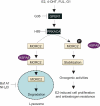Stabilization of MORC2 by estrogen and antiestrogens through GPER1- PRKACA-CMA pathway contributes to estrogen-induced proliferation and endocrine resistance of breast cancer cells
- PMID: 32401166
- PMCID: PMC7469550
- DOI: 10.1080/15548627.2019.1659609
Stabilization of MORC2 by estrogen and antiestrogens through GPER1- PRKACA-CMA pathway contributes to estrogen-induced proliferation and endocrine resistance of breast cancer cells
Abstract
Aberrant activation of estrogen signaling through three ESR (estrogen receptor) subtypes, termed ESR1/ERα, ESR2/ERβ, and GPER1 (G protein-coupled estrogen receptor 1), is implicated in breast cancer pathogenesis and progression. Antiestrogens tamoxifen (TAM) and fulvestrant (FUL) are effective for treatment of ESR1-positive breast tumors, but development of resistance represents a major clinical challenge. However, the molecular mechanisms behind these events remain largely unknown. Here, we report that 17β-estradiol (E2), TAM, and FUL stabilize MORC2 (MORC family CW-type zinc finger 2), an emerging oncoprotein in human cancer, in a GPER1-dependent manner. Mechanistically, GPER1 activates PRKACA (protein kinase cAMP-activated catalytic subunit alpha), which in turn phosphorylates MORC2 at threonine 582 (T582). Phosphorylated MORC2 decreases its interaction with HSPA8 (heat shock protein family A [Hsp70] member 8) and LAMP2A (lysosomal associated membrane protein 2A), two core components of the chaperone-mediated autophagy (CMA) machinery, thus protecting MORC2 from lysosomal degradation by CMA. Functionally, knockdown of MORC2 attenuates E2-induced cell proliferation and enhances cellular sensitivity to TAM and FUL. Moreover, introduction of wild-type MORC2, but not its phosphorylation-lacking mutant (T582A), in MORC2-depleted cells restores resistance to antiestrogens. Clinically, the phosphorylation levels of MORC2 at T582 are elevated in breast tumors from patients undergoing recurrence after TAM treatment. Together, these findings delineate a phosphorylation-dependent mechanism for MORC2 stabilization in response to estrogen and antiestrogens via blocking CMA-mediated lysosomal degradation and uncover a dual role for MORC2 in both estrogen-induced proliferation and resistance to antiestrogen therapies of breast cancer cells.
Abbreviations: 4-OHT: 4-hydroxytamoxifen; Baf A1: bafilomycin A1; CMA: chaperone-mediated autophagy; E2: 17β-estradiol; ESR: estrogen receptor; FUL: fulvestrant; GPER1: G protein-coupled estrogen receptor 1; HSPA8: heat shock protein family A (Hsp70) member 8; LAMP2A: lysosomal associated membrane protein 2A; MORC2: MORC family CW-type zinc finger 2; PRKACA: protein kinase cAMP-activated catalytic subunit alpha; TAM: tamoxifen; VCL: vinculin.
Keywords: Breast cancer; MORC2; chaperone-mediated autophagy; endocrine resistance; estrogen; estrogen receptor; lysosomal degradation.
Conflict of interest statement
No potential conflict of interest was reported by the authors.
Figures









Similar articles
-
Hydroxychloroquine inhibits autophagy to potentiate antiestrogen responsiveness in ER+ breast cancer.Clin Cancer Res. 2014 Jun 15;20(12):3222-32. doi: 10.1158/1078-0432.CCR-13-3227. Clin Cancer Res. 2014. PMID: 24928945 Free PMC article.
-
Tamoxifen resistance and metastasis of human breast cancer cells were mediated by the membrane-associated estrogen receptor ER-α36 signaling in vitro.Cell Biol Toxicol. 2017 Apr;33(2):183-195. doi: 10.1007/s10565-016-9365-6. Epub 2016 Nov 11. Cell Biol Toxicol. 2017. PMID: 27837347
-
GPR30-mediated HMGB1 upregulation in CAFs induces autophagy and tamoxifen resistance in ERα-positive breast cancer cells.Aging (Albany NY). 2021 Jun 28;13(12):16178-16197. doi: 10.18632/aging.203145. Epub 2021 Jun 28. Aging (Albany NY). 2021. PMID: 34182538 Free PMC article.
-
Antiestrogen resistance in breast cancer and the role of estrogen receptor signaling.Oncogene. 2003 Oct 20;22(47):7316-39. doi: 10.1038/sj.onc.1206937. Oncogene. 2003. PMID: 14576841 Review.
-
Molecular mechanisms of estrogen action: selective ligands and receptor pharmacology.J Steroid Biochem Mol Biol. 2000 Nov 30;74(5):279-85. doi: 10.1016/s0960-0760(00)00104-7. J Steroid Biochem Mol Biol. 2000. PMID: 11162936 Review.
Cited by
-
HSP90 N-terminal inhibitors target oncoprotein MORC2 for autophagic degradation and suppress MORC2-driven breast cancer progression.Clin Transl Med. 2022 May;12(5):e825. doi: 10.1002/ctm2.825. Clin Transl Med. 2022. PMID: 35522895 Free PMC article.
-
Identification of Genes Linking Natural Killer Cells to Apoptosis in Acute Myocardial Infarction and Ischemic Stroke.Front Immunol. 2022 Apr 1;13:817377. doi: 10.3389/fimmu.2022.817377. eCollection 2022. Front Immunol. 2022. PMID: 35432334 Free PMC article.
-
Missense mutations of GPER1 in breast invasive carcinoma: Exploring gene expression, signal transduction and immune cell infiltration with insights from cellular pharmacology.Biomed Rep. 2024 Nov 29;22(2):22. doi: 10.3892/br.2024.1900. eCollection 2025 Feb. Biomed Rep. 2024. PMID: 39720300 Free PMC article.
-
Biological functions and molecular mechanisms of MORC2 in human diseases.Mol Cells. 2025 Jan;48(1):100166. doi: 10.1016/j.mocell.2024.100166. Epub 2024 Dec 3. Mol Cells. 2025. PMID: 39637946 Free PMC article. Review.
-
Morc2a p.S87L mutant mice develop peripheral and central neuropathies associated with neuronal DNA damage and apoptosis.Dis Model Mech. 2021 Oct 1;14(10):dmm049123. doi: 10.1242/dmm.049123. Epub 2021 Oct 25. Dis Model Mech. 2021. PMID: 34695197 Free PMC article.
References
-
- Bray F, Ferlay J, Soerjomataram I, et al. Global cancer statistics 2018: GLOBOCAN estimates of incidence and mortality worldwide for 36 cancers in 185 countries. CA Cancer J Clin. 2018;68:394–424. - PubMed
-
- Yager JD, Davidson NE.. Estrogen carcinogenesis in breast cancer. N Engl J Med. 2006;354:270–282. - PubMed
-
- Thomas C, Gustafsson JA. The different roles of ER subtypes in cancer biology and therapy. Nat Rev Cancer. 2011;11:597–608. - PubMed
-
- Carroll JS, Brown M. Estrogen receptor target gene: an evolving concept. Mol Endocrinol. 2006;20:1707–1714. - PubMed
-
- Ignatiadis M, Sotiriou C. Luminal breast cancer: from biology to treatment. Nat Rev Clin Oncol. 2013;10:494–506. - PubMed
Publication types
MeSH terms
Substances
LinkOut - more resources
Full Text Sources
Other Literature Sources
Medical
Molecular Biology Databases
Miscellaneous
